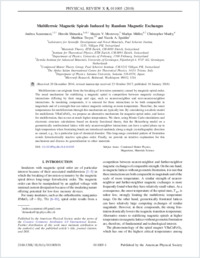Multiferroic magnetic spirals induced by random magnetic exchanges
- Scaramucci, Andrea Laboratory for Scientific Development and Novel Materials, Paul Scherrer Institut, Villigen PSI, Switzerland - Materials Theory, ETH Zurich, Switzerland
- Shinaoka, Hiroshi Institute for Theoretical Physics, ETH Zurich, Switzerland - Department of Physics, University of Fribourg, Switzerland - Department of Physics, Saitama University, Saitama, Japan
- Mostovoy, Maxim V. Zernike Institute for Advanced Materials, University of Groningen, Groningen, Netherlands
- Müller, Markus Condensed Matter Theory Group, Paul Scherrer Institute, Villigen PSI, Switzerland - The Abdus Salam International Centre for Theoretical Physics, Trieste, Italy
- Mudry, Christopher Condensed Matter Theory Group, Paul Scherrer Institute, Villigen PSI, Switzerland
- Troyer, Matthias Institute for Theoretical Physics, ETH Zurich, Switzerland - Microsoft Research, Redmond, Washington, USA
- Spaldin, Nicola A. Materials Theory, ETH Zurich, Switzerland
-
10.01.2018
Published in:
- Physical Review X. - 2018, vol. 8, no. 1, p. 011005
English
Multiferroism can originate from the breaking of inversion symmetry caused by magnetic-spiral order. The usual mechanism for stabilizing a magnetic spiral is competition between magnetic exchange interactions differing by their range and sign, such as nearest-neighbor and next-nearest-neighbor interactions. In insulating compounds, it is unusual for these interactions to be both comparable in magnitude and of a strength that can induce magnetic ordering at room temperature. Therefore, the onset temperatures for multiferroism through this mechanism are typically low. By considering a realistic model for multiferroic YBaCuFeO5, we propose an alternative mechanism for magnetic-spiral order, and hence for multiferroism, that occurs at much higher temperatures. We show, using Monte Carlo simulations and electronic structure calculations based on density functional theory, that the Heisenberg model on a geometrically nonfrustrated lattice with only nearest-neighbor interactions can have a spiral phase up to high temperature when frustrating bonds are introduced randomly along a single crystallographic direction as caused, e.g., by a particular type of chemical disorder. This long-range correlated pattern of frustration avoids ferroelectrically inactive spin-glass order. Finally, we provide an intuitive explanation for this mechanism and discuss its generalization to other materials.
- Faculty
- Faculté des sciences et de médecine
- Department
- Département de Physique
- Language
-
- English
- Classification
- Physics
- License
- License undefined
- Identifiers
-
- RERO DOC 306781
- DOI 10.1103/PhysRevX.8.011005
- Persistent URL
- https://folia.unifr.ch/unifr/documents/306260
Statistics
Document views: 71
File downloads:
- shi_mms.pdf: 136
